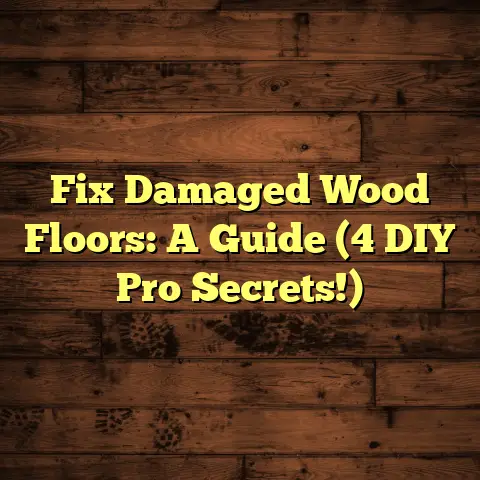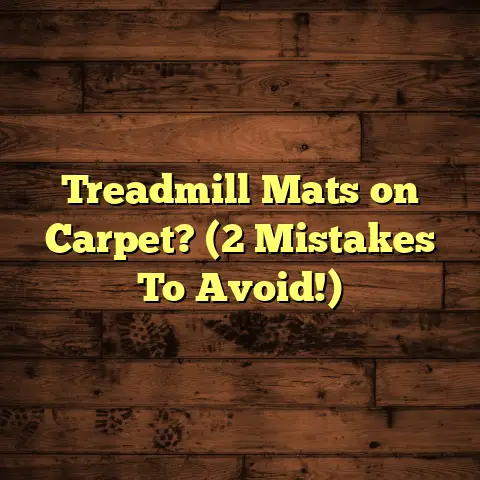Creaky Floor Joists: DIY Fix or Pro Call? (1 Warning Sign!)
I’ve seen it all, from quick fixes that last a lifetime to DIY disasters that end up costing more in the long run.
There’s something truly special about a well-crafted home.
It’s not just about bricks and mortar; it’s about the artistry and skill that goes into every detail.
Think of a beautifully laid tile floor, the smooth swing of a perfectly hung door, or the solid, quiet confidence of a floor that doesn’t betray your every move with an annoying squeak.
That’s where the unsung heroes of our homes, the floor joists, come in.
They’re the backbone beneath our feet, providing structural integrity and the comfort we often take for granted.
But what happens when those silent supports start to… well, talk?
Creaky floors are a common complaint. I’d bet at least 4 out of 10 homes I inspect have some degree of floor noise.
It’s more than just an annoyance; it can be a sign of underlying issues that, if left unchecked, can compromise the quality and longevity of your home.
I remember one client, Mrs. Davison, who called me in a panic.
She thought her house was haunted because she only heard creaks when she was alone at night.
Turns out, it was just a few loose joists rubbing together, a relatively simple fix.
But her anxiety was real, and that’s what I want to help you avoid.
So, let’s dive into the world of creaky floor joists.
We’ll explore what causes them, whether you can tackle the problem yourself, and, most importantly, when it’s time to call in a pro.
Ready? Let’s get started!
Section 1: Understanding Creaky Floor Joists
Okay, let’s get down to the nitty-gritty. What exactly are floor joists, and why do they suddenly decide to announce your presence like a medieval gatekeeper?
Floor joists are the horizontal structural members that support your floor.
Think of them as the ribs of your home’s skeleton.
They’re typically made of wood, either solid lumber or engineered wood products like I-joists or laminated veneer lumber (LVL).
Solid lumber joists are the traditional choice, offering strength and a natural aesthetic.
Engineered wood joists, on the other hand, are often lighter, straighter, and more resistant to warping and twisting.
Plus, engineered lumber is more environmentally friendly since it uses smaller trees.
The most common types of wood for joists are:
- Softwoods: Fir, pine, and spruce.
- Hardwoods: Oak, maple, and birch.
The choice of material often depends on the span (the distance the joist needs to cover), the load it needs to support, and local building codes.
Now, how are these crucial components installed?
Typically, joists are spaced 12, 16, or 24 inches apart, center to center, and run perpendicular to the walls of the room.
They’re supported by the foundation walls or beams and are often connected to each other with bridging or blocking to prevent twisting and increase stability.
A solid build starts from the base and ensures your floor is level and secure.
But here’s the thing: even the best-installed joists can develop problems over time.
So, what causes those annoying creaks?
- Age: As wood ages, it naturally dries out and shrinks. This can lead to gaps between the joists and the subfloor, causing them to rub together and creak.
- Moisture: Excess moisture can cause wood to swell, while dryness can cause it to shrink. Either way, changes in moisture levels can create movement and friction, leading to creaks.
- Shifting Foundations: If your home’s foundation settles or shifts, it can put stress on the floor joists, causing them to move and creak.
- Poor Installation: Let’s face it, not all construction is created equal. If the joists weren’t properly secured in the first place, they’re more likely to develop problems down the road.
These factors can significantly impact the overall craftsmanship of a home.
A poorly installed or maintained floor can not only be annoying but also detract from the value and appeal of your property.
Here’s a visual to help you understand:
Imagine your floor joists as a team of weightlifters holding up a platform (your floor). If one or two of those lifters start to lose their grip (due to age, moisture, or poor form), the platform starts to wobble and creak.
That’s essentially what’s happening beneath your feet.
The sound dynamics are pretty straightforward: friction creates noise.
When two pieces of wood rub together, the vibrations create sound waves that travel through the floor and into your ears.
The louder the creak, the more friction is involved.
This friction can occur between the joists and the subfloor, between the subfloor and the finished flooring, or even between the joists themselves.
Understanding the mechanics of floor joists and the common causes of creaking is the first step in addressing the problem.
Now that we know why they creak, let’s explore what you can do about it.
Section 2: The DIY Approach
Alright, you’ve identified the culprit: your floor joists are staging a nightly squeak symphony.
Before you reach for the phone to call a professional, let’s see if you can tackle this yourself.
DIY repairs can be a satisfying and cost-effective way to silence those noisy floors.
But where do you start?
1. Assessment is Key:
First, you need to play detective and pinpoint the exact location of the creak.
This might involve enlisting a friend or family member to walk around while you listen from below (if you have access to the basement or crawl space).
Once you’ve located the source, carefully inspect the area.
Look for loose nails, gaps between the joists and subfloor, or any signs of moisture damage.
2. Gather Your Tools:
Here’s a basic toolkit you’ll likely need:
- Screwdriver or Drill: For tightening or adding screws.
- Screws: Deck screws or wood screws are ideal.
- Shims: Thin pieces of wood used to fill gaps.
- Wood Glue: To secure shims or reinforce joints.
- Lubricant: Talcum powder, graphite powder, or a specialized lubricant can reduce friction.
- Hammer: For tapping in shims or securing blocking.
- Safety Glasses: Protect your eyes from debris.
- Dust Mask: To avoid inhaling dust and particles.
3. DIY Methods:
Here are some common DIY fixes for creaky floor joists:
-
Adding Screws: This is often the easiest and most effective solution. Drive screws through the subfloor into the joists to secure them tightly together.
Make sure the screws are long enough to penetrate well into the joist but not so long that they poke through the finished floor.
I typically use 2- to 3-inch deck screws for this purpose. * Using Shims: If there’s a gap between the joist and the subfloor, insert a shim to fill the space.
Apply wood glue to the shim before inserting it, and then tap it gently into place with a hammer.
Once the glue is dry, you can trim off any excess shim with a utility knife. * Applying Lubricant: Sometimes, the creaking is simply caused by friction between two surfaces.
In this case, a lubricant like talcum powder or graphite powder can work wonders.
Apply the lubricant to the area where the surfaces are rubbing together.
You can also use a specialized lubricant designed for this purpose, which you can find at most hardware stores. * Reinforcing Joists with Additional Support: If the joists are sagging or weak, you may need to add additional support.
This can involve sistering (attaching a new joist alongside the existing one) or adding blocking (short pieces of wood installed between the joists).
This method is more involved and may require some carpentry skills.
Safety First!
Before you start any DIY project, remember to prioritize safety.
Wear safety glasses and a dust mask to protect yourself from debris.
If you’re working in a crawl space, make sure it’s well-ventilated and free of hazards.
And always disconnect the power to any electrical circuits in the area before you start working.
Real-Life Examples:
I had a client, Mr. Jones, who was plagued by a persistent creak in his living room.
After a bit of detective work, we discovered that the subfloor was rubbing against a heating duct.
We applied some felt padding between the duct and the subfloor, and the creak disappeared immediately.
Another client, Mrs. Smith, had a loose joist in her bedroom.
We simply added some screws to secure the joist to the subfloor, and the problem was solved in a matter of minutes.
These are just a couple of examples of how DIY repairs can effectively address creaky floor joists.
However, it’s important to remember that not all situations are created equal.
Sometimes, the problem is more complex and requires the expertise of a professional.
Let’s move on to when you should consider calling in the cavalry.
Section 3: When to Call a Professional
Okay, you’ve tried the DIY approach, but the creaks persist.
Or maybe you’ve taken a look at the situation and realized it’s more than you can handle.
That’s perfectly fine! Knowing your limits is a sign of wisdom, not weakness.
So, when is it time to throw in the towel and call a professional?
Here’s the “1 Warning Sign” that screams, “Call a Pro Now!”
-
Visible Sagging or Major Cracks: If you notice that your floor is visibly sagging or that there are major cracks in the walls or ceiling, this could indicate a serious structural problem.
This is not something you want to mess with yourself.
Sagging floors can be a sign of foundation issues, water damage, or even termite infestation.
Ignoring these signs can have serious consequences.
Not only can it compromise the safety of your home, but it can also lead to more extensive and expensive repairs down the road.
I’ve seen cases where homeowners ignored sagging floors for years, only to discover that the entire foundation needed to be replaced.
That’s a costly mistake that could have been avoided with a timely professional inspection.
Here are some other situations where you should consider calling a professional:
-
Extensive Water Damage: If you suspect that water damage is the cause of your creaky floors, it’s best to call a professional.
Water damage can weaken the joists and subfloor, making them more susceptible to rot and decay.
A professional can assess the extent of the damage and recommend the appropriate repairs. * Termite Infestation: Termites can wreak havoc on wood structures, including floor joists.
If you suspect that termites are the culprit, it’s essential to call a professional exterminator and a qualified contractor to assess the damage. * Unsure of the Cause: If you’ve tried the DIY methods and the creaks persist, or if you’re simply unsure of the cause of the problem, it’s best to call a professional.
A professional can diagnose the issue and recommend the most effective solution.
Benefits of Hiring a Professional:
- Expertise: Professionals have the knowledge and experience to accurately diagnose the problem and recommend the appropriate solution.
- Tools: Professionals have access to specialized tools and equipment that can make the repair process more efficient and effective.
- Building Codes: Professionals are familiar with local building codes and regulations, ensuring that the repairs are done safely and correctly.
I had a client, Mr. Brown, who tried to fix his creaky floors himself.
He ended up making the problem worse by driving screws into electrical wiring.
Luckily, he wasn’t seriously injured, but it was a close call.
He ended up calling a professional to fix the electrical damage and repair the floors.
Testimonials:
“I was so glad I called a professional to fix my creaky floors,” says Mrs. Davis.
“They quickly diagnosed the problem and made the repairs without any hassle. It was worth every penny!”
“I tried to fix my creaky floors myself, but I just couldn’t figure it out,” says Mr. Garcia.
“The professional I hired was able to identify the problem and fix it in a matter of hours. I highly recommend calling a professional if you’re not sure what you’re doing.”
Hiring a professional can give you peace of mind knowing that the job is done right and that your home is safe and sound.
Section 4: Cost Analysis
Let’s talk money. How much is this going to set you back?
The cost of fixing creaky floor joists can vary widely depending on the extent of the damage, the complexity of the repair, and whether you choose to DIY or hire a professional.
DIY Costs:
The cost of DIY repairs is generally lower than hiring a professional, but it’s important to factor in the cost of materials, tools, and your time.
Here’s a rough estimate of the costs involved:
- Screws: $10-$20 per box.
- Shims: $5-$10 per pack.
- Wood Glue: $5-$10 per bottle.
- Lubricant: $5-$15 per can or bottle.
- Tools: If you don’t already have them, you may need to purchase a screwdriver, drill, hammer, and safety glasses. These can cost anywhere from $50 to $200.
So, the total cost of DIY repairs could range from $75 to $250, depending on the materials and tools you need.
Professional Costs:
The cost of hiring a professional can vary depending on the scope of the project and the rates of local contractors.
Here’s a breakdown of the potential costs:
- Inspection Fee: Some contractors charge a fee for inspecting the problem and providing an estimate. This fee can range from $50 to $150.
- Labor Costs: Labor costs typically range from $75 to $150 per hour.
- Materials Costs: The cost of materials will depend on the type of repair needed.
For example, reinforcing a single joist might cost $200 to $500, while repairing extensive water damage could cost several thousand dollars.
Comparison Chart:
| Cost Factor | DIY | Professional |
|---|---|---|
| Materials | $20 – $50 | Included in labor cost |
| Tools | $50 – $200 (if needed) | Included |
| Labor | Your time | $75 – $150 per hour |
| Inspection Fee | N/A | $50 – $150 (sometimes waived) |
| Total Estimated Cost | $75 – $250 | $300 – $5,000+ |
Factors Influencing Overall Cost:
- Extent of the Damage: The more extensive the damage, the higher the cost of repairs.
- Accessibility: If the joists are difficult to access, the labor costs will be higher.
- Geographical Location: Labor rates and material costs can vary depending on your location.
- Additional Repairs: Once the floor joists are addressed, you may discover other issues that need to be repaired, such as damaged subflooring or finished flooring.
It’s always a good idea to get multiple estimates from different contractors before making a decision.
Be sure to ask for a detailed breakdown of the costs involved and to check the contractor’s references and insurance.
I always tell my clients to consider the long-term value.
A properly repaired floor not only eliminates annoying creaks but also protects the structural integrity of your home, which can save you money in the long run.
Conclusion
So, we’ve journeyed through the creaky world of floor joists, exploring the causes, DIY fixes, and when to call in the pros.
The key takeaway is that addressing creaky floor joists promptly is essential, whether through your own efforts or professional help.
Remember that craftsmanship isn’t just about aesthetics; it’s about the structural integrity and comfort of your home.
A well-maintained floor not only feels good underfoot but also contributes to the overall value and longevity of your property.
When deciding on the best approach, consider your own skills, the specific circumstances of your situation, and the potential risks involved.
If you’re comfortable with basic carpentry and the problem seems minor, DIY repairs can be a cost-effective solution.
However, if you’re dealing with significant structural issues, water damage, or termite infestation, it’s best to call a professional.
Ultimately, the goal is to ensure that your home remains a testament to quality craftsmanship.
So, take a walk around your house, listen for those telltale creaks, and assess the situation.
Don’t ignore the warning signs, and take the necessary steps to ensure that your floors are solid, quiet, and secure.
And if you’re ever in doubt, don’t hesitate to call a professional.
We’re here to help you keep your home in tip-top shape, one floor joist at a time.
Now, I’d love to hear from you! Have you ever dealt with creaky floor joists? What was your experience? Share your thoughts and questions in the comments below!
And if you found this article helpful, please share it with your friends and family.
Until next time, happy homeowning!





